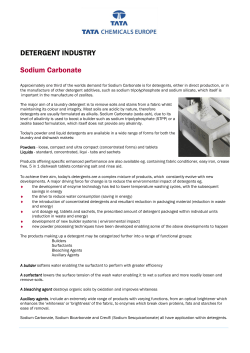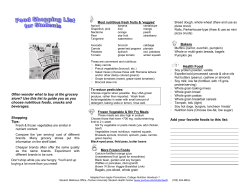
Document 214905
Appendix_A.fm Page 3 Monday, June 21, 2004 6:59 AM How to Use the Elements Handbook 1 Look for data that First Ionization Energy Group 1A: Alkali Metals Atomic Properties • Alkali metals have an electron configuration that ends in ns1. Physical Properties Li Lithium 6.941 11 Na Lithium | discovered in 1817 by Johan August Arfvedson 2 8 1 Sodium | discovered in 1807 by Sir Humphry Davy 2 8 8 1 Potassium | discovered in 1807 by Sir Humphry Davy 1 • The presence of a single valence electron also explains the low melting points and boiling points of alkali metals. Sodium 22.990 19 K Rb 2 8 18 8 1 Rubidium 85.468 55 Cs 2 8 18 18 8 Cesium 1 132.91 87 Fr 2 8 18 32 18 Pure alkali metals are stored under oil because they will tarnish on exposure to oxygen or moisture in air. Melting and Boiling Points Rubidium | discovered in 1861 by Robert Bunsen & Gustav Kirchhoff Cesium | discovered in 1860 by Robert Bunsen & Gustav Kirchhoff Temperature (C) 37 • The atoms of alkali metals are the largest in their periods. 1500 1336 Francium | discovered in 1939 by Marguerite Perey 2 883 900 758 700 670 600 300 0 179 Li 98 64 39 28 Na K Rb Cs Na Ionic radius (pm) 0.97 • The alkali metals are the most reactive metals. Li Na K Rb • All alkali metals react with water to form an alkaline solution. Example: Cs 2K(s) 2H2O(l) • Sodium is the only alkali metal manufactured on a large scale. It is generally produced by the electrolysis of molten sodium chloride. Rb Cs Fr 0.25 0 Cs Li Na Li 156 Na 191 K 238 Rb 255 Cs 273 60 + Li 95 Na+ 133 K+ 148 Rb+ 169 Cs+ Sodium K Potassium Rubidium Molten Na 2Na(l) Cl2(g) to reveal trends in properties within a group. Calcium 3 Learn where Graphite anode () 5 4 Find examples of typical chemical reactions. Uses of NaOH Pulp and Paper 5% 14% LiOH(aq) H2(g) 13% 4% Soaps and Detergents Petroleum • Potassium superoxide, KO2, is a source of oxygen in submarines. It removes CO2 from the atmosphere as it produces oxygen. 4KO2(s) 2CO2(g) elements exist in nature and how they are processed. • Sodium hydroxide, NaOH, is used as a drain cleaner. It is also used to produce other chemicals and in many industrial processes. Na2CO3(s) CO2(g) H2O(g) H 129 kJ/mol LiH(s) H2O(l) Steel cathode () Lithium and potassium are produced by a similar process. describes what the elements in a group have in common. 2 Interpret graphs • Lithium carbonate, Li2CO3, is a prescription medicine for chronic depression. • Lithium hydride is a convenient source for hydrogen. Molten NaCl Na(l ) Iron screen 0.7 • Sodium hydrogen carbonate, NaHCO3, is used in fire extinguishers. produces CO2(g) and steam, which causes baked goods to rise. Cl2(g ) 2NaHCO3(s) • The mineral sylvite, KCl, is a source of potassium. 0.7 • Potassium nitrate, KNO3, is used in matches and chemical fertilizers. 2CsCl(s) H 442.8 kJ/mol 4 • Sodium hydrogen carbonate (baking soda) Manufacture of Sodium NaCl 0.8 0.5 • Sodium hypochlorite, NaOCl, is used as a bleach and to disinfect swimming pools. 2KOH(aq) H2(g) 2Cs(s) Cl2(g) • Alkali metals do not occur uncombined in nature because they are highly reactive. Rb 0.8 0.75 0.86 0.53 • All alkali metals react with halogens to form an ionic halide. Example: • Sodium occurs widely as sodium chloride in underground salt and brine deposits. It is a major component of seawater. K Lithium 3 2NaCl(l) Li 0.9 Important Compounds and Reactions Francium 8 1 (223) Sources 376 150 1.88 1 0 403 300 1.0 1.53 1.5 0.5 419 1.0 Alkali metals can be identified by the colors produced when their compounds are heated in a flame. Density bp mp 1200 Electronegativity 496 450 Atomic radius (pm) • Cesium metal is used in photocells because its first ionization energy is very low. 2 Potassium 39.098 520 0 • Alkali metals form ions with a 1 charge. • Alkali metals are silver-gray solids that are soft enough to cut with a knife. They are soft because they have only one valence electron. Density (g/cm3) 2 1 3 Energy (kJ/mol) 600 Electronegativity Handbook Elements Other Industries 35% 32% Organic Chemicals Inorganic Chemicals 2K2CO3(s) 3O2(g) R6 Elements Handbook R7 Group 1A: Alkali Metals 5 Find out which compounds have important industrial uses. 6 Make connections Group 2A: Alkaline Earth Metals Mg Chlorophyll Sr A plant that is deprived of magnesium will turn yellow and eventually die. The yellow color is a sign that the plant is not producing enough of the green pigment chlorophyll, which is found in structures called chloroplasts. There are about half a million chloroplasts in one square millimeter of leaf surface. In chloroplasts, light energy is changed to chemical energy. Producing an aerial fireworks display requires skill and knowledge of chemistry. Shells are stored in steel pipes anchored in sand. A typical shell contains two The name of this effect is chrysanthemum. charges, one to launch the shell and one to cause the shell to burst. When the lifting charge explodes, the shell is blown out of the pipe and the fuse attached to the bursting charge ignites. The shell travels for a few seconds before it bursts. Chlorophyll molecules absorb wavelengths of blue light and red light, and reflect green light. There is a magnesium ion at the center of each chlorophyll molecule. It is embedded like a jewel in a crown-like ring. The magnesium ion forms a bond with each nitrogen atom. CH2 CH H C The chemical reactions that form a limestone cave are simple. Carbon dioxide in the air dissolves in rain to form weak carbonic acid, H2CO3. As rain passes through soil, it dissolves carbon dioxide produced by decaying plants and becomes even more acidic. The rainwater seeps into limestone, CaCO3, beneath the soil. The CaCO3 dissolves in the carbonic acid, forming a solution of calcium hydrogen carbonate, Ca(HCO 3)2. Ba Fireworks The explosions that launch the shells and cause them to burst are exothermic redox reactions. The reducing agent, or fuel, may be aluminum, magnesium, or sulfur. The oxidizing agent may be a nitrate, a chlorate, or a perchlorate, such as potassium perchlorate (KClO4). When a shell bursts, it releases tiny pellets called “stars,” which produce the colors. Only a few elements are needed to produce these colors. Two are alkaline earth metals, strontium for bright red and barium for light green. These same colors are produced when strontium and barium compounds are heated in a flame. Flame tests can identify elements because an element emits characteristic wavelengths of light when its atoms absorb heat and then return to the ground state. ■ 7 Ca Limestone Caves CaCO3(s) H2CO3(aq) 6 N CH Mg N H H3C H N C CH3 CH2 HC C O CH2 chemical reactions on the environment. Ca (aq) 2HCO (aq) Over millions of years, as more and more limestone dissolves, a cave forms and slowly grows in size. Once the cave stops growing, another process may occur. Calcium hydrogen carbonate solution drips through the cave’s roof. Carbon dioxide is released from solution, leaving behind a tiny deposit of solid calcium carbonate. Ca2(aq) 2HCO3(aq) 8 Find out the effects CaCO 3(s) CO 2(g) H 2O(l) The deposit slowly grows into a stalactite, which hangs from the ceiling like an icicle. Drops of solution that fall from the ceiling form stalagmites on the cave floor. Calcium carbonate is white. So any color in the deposits is due to traces of metal ions, such as copper (blue-green) and iron (red-brown). The growth rate of the formations depends mainly on the volume of water that drips through the roof and the concentration of calcium bicarbonate in the water. In many caves, the rate of growth is measured in centimeters per hundreds or thousands of years. ■ of certain chemicals on your health. 9 Discover some fun Stalactites and stalagmites may join together to form columns. CH2CH3 N 7 Explore the impact of 3 2 facts about elements. CH3 H3C HC between chemistry and technology. Handbook Elements COOCH3 COOC20H39 Chlorophyll a Chlorophyll is typical of a family of compounds called porphyrins, which contain a central metal ion. In heme, the ion is Fe2. There are four heme molecules in hemoglobin, which transports oxygen in the blood. ■ R12 Elements Handbook Labels for shells used in a fireworks display describe the color and the effect produced by the shell. Ca Building Strong Bones As a young adult, you can have a major effect on the health of your bones later in life. You acquire 90% of the bone tissue in your skeleton before age 18 as females and age 20 as males. Physical activity and the amount of calcium in your diet affect the buildup of bone mass. To maintain a constant level of calcium in your blood, your body may release calcium from bone tissue. 8 If enough calcium is lost from bones, they become brittle and tend to break easily. This condition, known as osteoporosis, is most common in older people. However, it can occur in young and middle-aged adults. The recommended daily intake of calcium from age 9 to age 18 is 1.3 g per day. This is the amount in a liter of milk. Calcium-fortified foods, such as orange juice, are a good choice for those who cannot tolerate the lactose in milk. Vitamin D in orange juice helps you absorb calcium. ■ ? 9 Did You Know... Calcium oxide (lime) emits a bright white light when it is heated. Before electric lights, theaters used lime to focus light on a single actor. So the expression in the limelight describes a person in a prominent position. Group 2A: Alkaline Earth Metals R13 R3
© Copyright 2025





















